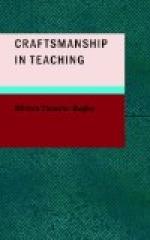IV
Lacking this accurate type of data regarding methods, the next recourse is to the actual teaching of those teachers who are recognized as efficient. Wherever such a teacher may be found, his or her work is well worth the most careful sort of study. Success, of course, may be due to other factors than the methods employed,—to personality, for example. But, in every case of recognized efficiency in teaching that I have observed, I have found that the methods employed have, in the main, been productive of good results when used by others. The experienced teacher comes, through a process of trial and error, to select, perhaps unconsciously, the methods that work best. Sometimes these are not always to be identified with the methods that theoretical pedagogy had worked out from a priori bases. For example, the type of lesson which I call the “deductive development” lesson[7] is one that is not included in the older discussions of method; yet it accurately describes one of the methods employed by a very successful teacher whose work I observed.
One way, then, to improve the efficiency of young teachers, in so far as improvement in methods leads to improved efficiency, is to encourage the observation of expert teaching. The plan of giving teachers visiting days often brings excellent results, especially if the teacher looks upon the privilege in the proper light. The hyper-critical spirit is fatal to growth under any condition. Whenever a teacher has come to the conclusion that he or she has nothing to learn from studying the work of others, anabolism has ceased and katabolism has set in. The self-sufficiency of our craft is one of its weakest characteristics. It is the factor that more than any other discounts it in the minds of laymen. Fortunately it is less frequently a professional characteristic than




